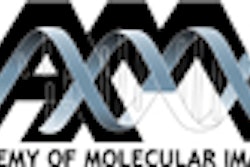By Michael Tweedle, Ph.D.
Academy of Molecular Imaging
Click here for Part I.

One can imagine imaging scenarios where the gain or loss of this protein could reflect the relative ongoing success of certain cytotoxics. These agents are partially excreted by the hepatobiliary system, so liver function monitoring is a possibility. Some gadolinium formulations have also been shown to undergo enterohepatic recirculation, allowing the colon wall to be enhanced in the presence of fecal matter in MR colonography.
The HAS-+binding Gd agents are also being investigated as indicators of microvessel leakiness. The latter may depend to some extent on the kinetics of association and dissociation of the Gd agents from the circulating and localized albumin, parameters which are imperfectly understood. The newly minted biologic agent Avastin (Genentech, South San Francisco, CA) has recently been shown to effectively block angiogenesis in humans through binding of vascular endothelial growth factor (VEGF), a principal pathway element, and imaging is an obvious candidate for monitoring the agent’s effectiveness.
Other angiogenesis applications are also being targeted by drugs that bind to one or several simultaneous angiogenesis targets. Multiple-target drugs may be more effective because of the ability of malignancies to alter their phenotype, researchers hypothesize. So while HSA binders might read on some physiologic parameter related to angiogenesis, it is likely that more specific diagnostic imaging agents will be useful in determining the receptor status of patients being considered for various anti-angiogenesis treatments.
Many but not all tumors also lay down considerable fibrin, often to the detriment of the patient who presents with vascular thrombotic events (VTE) that are surprisingly common. For example, the incidence of VTE was 24% in breast cancer after cytotoxic agents and tamoxifen (Second International Conference on Thrombosis and Hemostasis Issues in Cancer, Bergamo, Italy, September 2003).
The fibrin deposits are found not only in the deep veins of the limbs, but also scattered throughout the abdomen, especially after surgery, when whole-body techniques would be needed to find them. VTE is exacerbated by chemo- and radiotherapy, and reportedly especially after anti-angiogenesis treatment. What relationships exist between fibrin deposit and tumor aggressiveness? Could fibrin-bound agents predict or monitor therapy?
Evidence is mounting that the angiogenesis and coagulation mechanisms are closely related in cancer. Targeted drugs may help to answer some of these questions. Selecting patients for and monitoring of clot-dissolving drugs is also an interesting possibility for the fibrin-binding Gd chelates.
Because some angiogenesis receptors are located on the luminal side of endothelial cells, it is conceivable that large clustered Gd devices or Fe particles could be targeted there, and indeed reports exist of several of these. For example, images have been released of Gd clusters loosely based on liposome or lipid particles containing 104-105 Gd chelates plus monoclonal antibodies to αvβ3 (Kereos, St. Louis). This combination appears to have the mathematical muscle combined with target accessibility.
It is tempting to speculate that some of these lipidic multi-Gd or Fe particulate agents might also be used to image plaques, whose management is the subject of billions of dollars of R&D. Plaque imaging with nuclear medicine has been relatively unproductive due to spatial resolution limitations. However, coronary plaques are accessible to blood-born agents directly, allowing for binding by large multimers and clusters targeted to, for example, inflammation markers, macrophages, or even fibrin (thought to be present in some unstable plaques).
One hurdle here is the difficulty of performing MRI in the living coronary artery. MRI needs very small voxels for high resolution in these small structures, but obtaining such resolution in the presence of non-linear motion from the beating heart requires highly advanced technology. For contrast enhancement, there is also a need to demonstrate that a monolayer of Gd can be imaged in a clinically reasonable (~1 mm3) voxel.
The water molecules in all corners of the voxel will need to travel to the Gd, and be exchanged and relaxed in the time frame of the MRI experiment. This problem is probably not present in capillary targets (e.g. angiogenesis) where >100 capillary segments are expected to be present three dimensionally in a voxel.
However, voxels are steadily shrinking due to technology improvements, and images of a surface have been detected in vitro with voxels approaching half the size of those used in clinical practice. Plaques have also been imaged with Fe particulates that work by magnetic susceptibility to affect T2, where accumulation is through natural macrophage activity.
Targeted MRI agents, nascent on the imaging scene, are extremely attractive conceptually, and exist in a few potentially useful examples. Research has been driven by the attraction of MRI as an imaging modality and will certainly continue to create examples.
The targeted MRI agents, like all imaging agents, carry limitations -- in this case the sensitivity of detection in images. Currently, the workable situations are in very high-capacity targets like fibrin, which is present in sufficient quantity to be seen with simple targeted Gd chelates, or in targets accessible to the blood stream that can be bound with a Gd cluster, polymer, or an iron particle. This is currently a very limited target set, but even within these limits, drug development applications are possible.
MRI-accessible targets whose detection is crucial in drug development could also include in vitro biomarkers. The criteria for usefulness are similar to the in vivo situation in terms of absolute concentration of agent required and accessibility, but amplification schemes are obviously easier to create in-vitro. However, in many if not most of these situations, the limitations of in vivo light imaging (low depth of penetration) do not exist, so MRI loses some of its inherent advantages.
Unforeseen breakthroughs in the underlying agent technology could have an immediate and profound effect on the number of targeted MRI agents invented, but the chemistry that could create a major breakthrough is not obvious.
By Michael Tweedle, Ph.D.AuntMinnie.com contributing writer
June 11, 2004
Michael Tweedle is a council director of the AMI's Society of Non-Invasive Imaging in Drug Development (SNIDD). He also is president of Bracco Research USA in Princeton, NJ.
Related Reading
Part I: Can biochemically-targeted MRI agents improve drug development?, June 11, 2004
Dual-contrast MRI susses out more liver metastases than FDG-PET, May 7, 2004
Radioactive microsphere therapy an option for liver cancer with poor portal flow, April 29, 2004
US, MRI challenge CT for classifying renal cell carcinoma, June 17, 2003
Copyright © 2004 Academy of Molecular Imaging



















